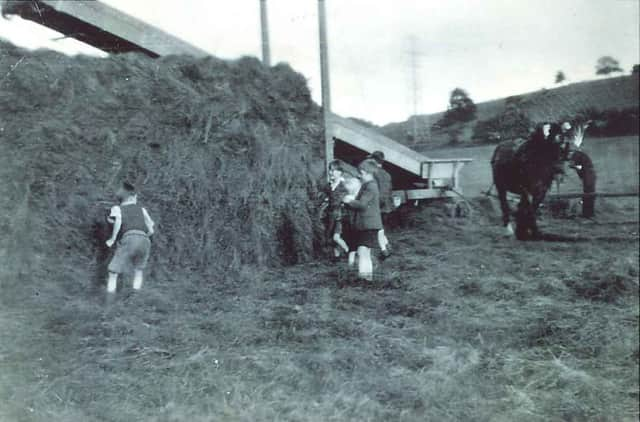Time to hit the hay


He sent in this photo, taken by his late father Eddie Richardson, which shows a typical scene of rick-building in the early 1950s on Stan Brown’s farm at Singleton, in a field close to the Leys where the family lived at that time.
Mr Richardson writes: Haymaking times were a magnet for the local youngsters as we watched the field being cut by tractors with sharp-toothed blade attachments, and woe betide any young rabbits or nesting birds in the way! The tractors were usually blue Fordsons, but I remember the farm had one with the delightfully distinctive name Alice Chalmers – it had an exceptionally-long steering column.
Advertisement
Hide AdAdvertisement
Hide AdThe cut hay was gathered up by tractors with fork attachments on the front and deposited at the base of the elevator on which it was carried to the top of the rick where farmworkers spread it evenly around the ever-growing structures.
The elevator was literally horse-powered, the animal continuously plodding around in the same circle with a bar attached from its collar/harness to a gib (a windlass mechanism) which worked the elevator by a chain drive.
Hopefully my memory and subsequent knowledge are basically correct? The process worked quite well unless the horse stopped for some reason and had to be ‘encouraged’ to resume its well-worn path which remained visible for weeks afterwards.
Mr Charlie Treagus, who lived in the flint cottage at bankside, was responsible for the farm’s two heavy horses – I’ve forgotten their names – and he took good care of them. The finished rick was usually thatched to make it weatherproof, but unfortunately rick fires were fairly common due mainly to unintended build-up of heat, and some would steam and smoke for days before catching fire. This old-fashioned method of haymaking was such a contrast to today’s automated process of cutting and compressing the hay into large rolls ready wrapped in plastic sheeting for storage as winter fodder!
Advertisement
Hide AdAdvertisement
Hide AdFor us youngsters the haymaking field became something of an adventure playground, exciting fun-filled days with games such as chase and catch, which we called ‘hee’, hide and seek, even climbing and hiding in the rick when the men weren’t around! No ‘health and safety’ restraints back then – if we became a nuisance we were told in no uncertain terms to ‘clear off’, but we soon returned and resumed our activities.
The boys featured in the photo playing around the rick are, from left – Jim Finlayson, Michael Kerridge, me or possibly my brother Robert? (the small fair haired one), and Chris Knight. I can’t identify the fifth boy on the right (back view only) or the farmworker near the horse.
At other times we spent most of our leisure days outdoors, going on bike rides, roaming the Downs, building camps in the woods, climbing trees, looking for birds’ nests, etc.
One of our favourite places was Semmens Dene Bottom Wood up towards the Trundle, adjacent to the top of Town Lane. It was there that we fashioned our bows and arrows from the supple branches of hazel trees. We would sometimes compete to see who could shoot an arrow the highest over the top of the local electricity pylon cables! ‘Let’s go up the Sem’ was a frequent suggestion among us – it was a typical old English wood, but was cut down in the later years and replaced with firs.
Advertisement
Hide AdAdvertisement
Hide AdIn winter, if we had snow, we would haul our home-made sledges up the surrounding hills, whizz down, and repeat the process many times. We would often return home cold, wet, bruised, but happy! If the local duck pond was frozen over, this became another venue for enjoyable activities such as skating or sliding.
Very few village people had a TV, telephones, or a car at the beginning of the 1950s and there were no computers, etc, to keep us indoors. Mobile phones, Facebook and Twitter were decades away! Life was indeed much simpler and slower then, but it would change over the next decade or so as the country finally shook off its wartime hangover and society began to embrace the 20th century with its modernisation and improvements in many areas. But those outdoor days 60-plus years ago instilled in me a love for the countryside and will always be part of my fond memories of a bygone era.